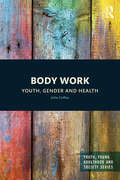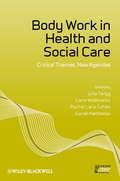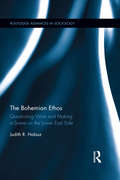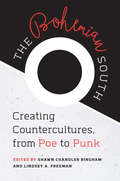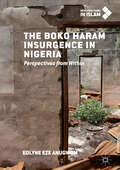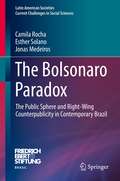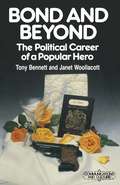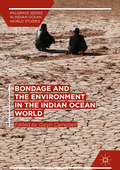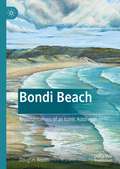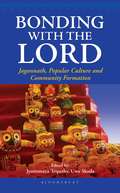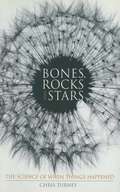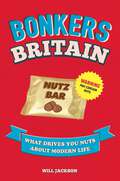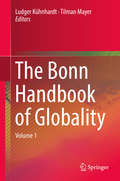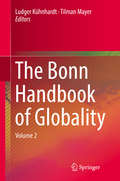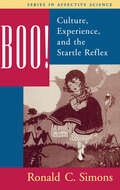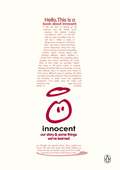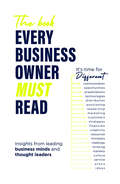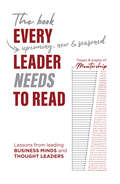- Table View
- List View
Body Technologies in the Greco-Roman World: Technosôma, gender and sex
by Maria Gerolemou and Giulia Maria ChesiA collection of papers that introduces the notion of the technosoma (techno body) into discussions on the representations of the body in classical antiquity. By applying the category of the technosoma to the ‘natural’ body, this volume explicitly narrows down the discussion of the technical and the natural to the physiological body. In doing so, the present collection focuses on body technologies in the specific form of beautification and body enhancement techniques, as well as medical and surgical treatments. The volume elucidates two main points. Firstly, ancient techno bodies show that the categories of gender and sexuality are at the core of the intersection of the natural and the technical, and intersect with notions of race, age, speciesism, class and education, and dis/ability. Secondly, the collection argues that new body technologies have in fact a very ancient history that can help to address the challenges of contemporary technological innovation. To this end, the volume showcases the intersection of ‘natural’ bodies with technology, gender, sexuality and reproduction. On the one hand, techno bodies tend to align with normative ideas about gender, and sexuality. On the other hand, body modification and/or enhancement techniques work hand in hand with economic and political power and knowledge, thus they often produce techno bodies that are shaped according to individual needs, i.e. according to a certain lifestyle. Consequently, techno bodies threaten to alter traditional ideas of masculinity, femininity, male and female sexuality and beauty.
Body Technologies in the Greco-Roman World: Technosôma, gender and sex
A collection of papers that introduces the notion of the technosoma (techno body) into discussions on the representations of the body in classical antiquity. By applying the category of the technosoma to the ‘natural’ body, this volume explicitly narrows down the discussion of the technical and the natural to the physiological body. In doing so, the present collection focuses on body technologies in the specific form of beautification and body enhancement techniques, as well as medical and surgical treatments. The volume elucidates two main points. Firstly, ancient techno bodies show that the categories of gender and sexuality are at the core of the intersection of the natural and the technical, and intersect with notions of race, age, speciesism, class and education, and dis/ability. Secondly, the collection argues that new body technologies have in fact a very ancient history that can help to address the challenges of contemporary technological innovation. To this end, the volume showcases the intersection of ‘natural’ bodies with technology, gender, sexuality and reproduction. On the one hand, techno bodies tend to align with normative ideas about gender, and sexuality. On the other hand, body modification and/or enhancement techniques work hand in hand with economic and political power and knowledge, thus they often produce techno bodies that are shaped according to individual needs, i.e. according to a certain lifestyle. Consequently, techno bodies threaten to alter traditional ideas of masculinity, femininity, male and female sexuality and beauty.
Body Work: Youth, Gender and Health (Youth, Young Adulthood and Society)
by Julia CoffeyThe rise of the health, beauty and fitness industries in recent years has led to an increased focus on the body. Body image, gender and health are issues of long-standing concern in sociology and in youth studies, but a theoretical and empirical focus on the body has been largely missing from this field. This book explores young people’s understandings of their bodies in the context of gender and health ideals, consumer culture, individualisation and image. Body Work examines the body in youth studies. It explores paradoxical aspects of gendered body work practices, highlighting the contradiction in men’s increased participation in these industries as consumers alongside the re-emphasis of their gendered difference. It explores the key ways in which the ideal body is currently achieved, via muscularising practices, slimming regimes and cosmetic procedures. Coffey investigates the concept of ‘health’ and how it is inextricably linked both to the bodily performance of gender ideals and an increased public emphasis on individual management and responsibility in the pursuit of a ‘healthy’ body. This book’s conceptual framework places it at the forefront of theoretical work concerning bodies, affect and images, particularly in its development of Deleuzian research. It will appeal to a wide range of scholars and students in fields of youth studies, education, sociology, gender studies, cultural studies, affect and body studies.
Body Work: Youth, Gender and Health (Youth, Young Adulthood and Society)
by Julia CoffeyThe rise of the health, beauty and fitness industries in recent years has led to an increased focus on the body. Body image, gender and health are issues of long-standing concern in sociology and in youth studies, but a theoretical and empirical focus on the body has been largely missing from this field. This book explores young people’s understandings of their bodies in the context of gender and health ideals, consumer culture, individualisation and image. Body Work examines the body in youth studies. It explores paradoxical aspects of gendered body work practices, highlighting the contradiction in men’s increased participation in these industries as consumers alongside the re-emphasis of their gendered difference. It explores the key ways in which the ideal body is currently achieved, via muscularising practices, slimming regimes and cosmetic procedures. Coffey investigates the concept of ‘health’ and how it is inextricably linked both to the bodily performance of gender ideals and an increased public emphasis on individual management and responsibility in the pursuit of a ‘healthy’ body. This book’s conceptual framework places it at the forefront of theoretical work concerning bodies, affect and images, particularly in its development of Deleuzian research. It will appeal to a wide range of scholars and students in fields of youth studies, education, sociology, gender studies, cultural studies, affect and body studies.
Body Work in Health and Social Care: Critical Themes, New Agendas (Sociology of Health and Illness Monographs #14)
by Julia Twigg Carol Wolkowitz Rachel Lara Cohen Sarah NettletonThe first book to fully explore the multiple ways in which body work features in health and social care and the meanings of this work both for those employed to do it and those on whose bodies they work. Explores the commonalities between different sectors of work, including those outside health and social care Contributions come from an international range of experts Draws on perspectives from across the medical, therapeutic, and care fields Incorporates a variety of methodological approaches, from life history analysis to ethnographic studies and first person accounts
Body Work in Health and Social Care: Critical Themes, New Agendas (Sociology of Health and Illness Monographs #13)
by Julia Twigg Carol Wolkowitz Rachel Lara Cohen Sarah NettletonThe first book to fully explore the multiple ways in which body work features in health and social care and the meanings of this work both for those employed to do it and those on whose bodies they work. Explores the commonalities between different sectors of work, including those outside health and social care Contributions come from an international range of experts Draws on perspectives from across the medical, therapeutic, and care fields Incorporates a variety of methodological approaches, from life history analysis to ethnographic studies and first person accounts
The Bohemian Ethos: Questioning Work and Making a Scene on the Lower East Side (Routledge Advances in Sociology)
by Judith R. HalaszThe iconoclastic ingenuity of bohemians, from Gerard de Nerval to Allen Ginsberg, continually captivates the popular imagination; the worlds of fashion, advertising, and even real estate all capitalize on the alternative appeal of bohemian style. Persistently overlooked, however, is bohemians' distinctive relationship to work. In this book, sociologist Judith R. Halasz examines the fascinating junctures between bohemian labor and life. Weaving together historiography, ethnography, and personal experiences of having been raised amidst downtown New York's bohemian communities, Halasz deciphers bohemians' unconventional behaviors and attitudes towards employment and the broader work world. From the nineteenth-century harbingers on Paris' Left Bank to the Beats, Underground, and more recent bohemian outcroppings on New York's Lower East Side, The Bohemian Ethos traces the embodiment of a politically charged yet increasingly precarious form of cultural resistance to hegemonic social and economic imperatives.
The Bohemian Ethos: Questioning Work and Making a Scene on the Lower East Side (Routledge Advances in Sociology #143)
by Judith R. HalaszThe iconoclastic ingenuity of bohemians, from Gerard de Nerval to Allen Ginsberg, continually captivates the popular imagination; the worlds of fashion, advertising, and even real estate all capitalize on the alternative appeal of bohemian style. Persistently overlooked, however, is bohemians' distinctive relationship to work. In this book, sociologist Judith R. Halasz examines the fascinating junctures between bohemian labor and life. Weaving together historiography, ethnography, and personal experiences of having been raised amidst downtown New York's bohemian communities, Halasz deciphers bohemians' unconventional behaviors and attitudes towards employment and the broader work world. From the nineteenth-century harbingers on Paris' Left Bank to the Beats, Underground, and more recent bohemian outcroppings on New York's Lower East Side, The Bohemian Ethos traces the embodiment of a politically charged yet increasingly precarious form of cultural resistance to hegemonic social and economic imperatives.
The Bohemian South: Creating Countercultures, from Poe to Punk
by Lindsey A. Freeman Shawn Chandler BinghamFrom the southern influence on nineteenth-century New York to the musical legacy of late-twentieth-century Athens, Georgia, to the cutting-edge cuisines of twenty-first-century Asheville, North Carolina, the bohemian South has long contested traditional views of the region. Yet, even as the fruits of this creative South have famously been celebrated, exported, and expropriated, the region long was labeled a cultural backwater. This timely and illuminating collection uses bohemia as a novel lens for reconsidering more traditional views of the South. Exploring wide-ranging locales, such as Athens, Austin, Black Mountain College, Knoxville, Memphis, New Orleans, and North Carolina's Research Triangle, each essay challenges popular interpretations of the South, while highlighting important bohemian sub- and countercultures. The Bohemian South provides an important perspective in the New South as an epicenter for progress, innovation, and experimentation.Contributors include Scott Barretta, Shawn Chandler Bingham, Jaime Cantrell, Jon Horne Carter, Alex Sayf Cummings, Lindsey A. Freeman, Grace E. Hale, Joanna Levin, Joshua Long, Daniel S. Margolies, Chris Offutt, Zandria F. Robinson, Allen Shelton, Daniel Cross Turner, Zackary Vernon, and Edward Whitley.
The Boko Haram Insurgence In Nigeria: Perspectives from Within (New Directions in Islam)
by Edlyne Eze AnugwomThis book focuses on the Boko Haram insurgence in Nigeria, and provides information on the origin and growth of the sect, antecedent and historical factors behind the insurgence, assessing a variety of socio-political drivers. The structure, organization and ideology of the sect are analysed, paying attention to internal splits within the group, as well as external relations with the Nigerian state, and global jihadism. The diverse and wide ranging issues covered in the book makes it valuable for academic researchers, students and policy practitioners both within Africa and beyond.
The Bolsonaro Paradox: The Public Sphere and Right-Wing Counterpublicity in Contemporary Brazil (Latin American Societies)
by Camila Rocha Esther Solano Jonas MedeirosThis book presents the first in-depth academic investigation published in English about one of the most radical incarnations of the current global wave of new right-wing movements and governments: the movement that brought to power the current Brazilian president, Jair Bolsonaro. The rise of this new right-wing movement in Brazil came as a surprise to many analysts who used to see the country as a successful example of the implementation of progressive social policies in the first decade of the 21st century, and posed many questions to those seeking to understand the role Brazil now plays in the development of this international far-right wave. The authors of this volume try to answer some of these questions by presenting the results of an extensive field research conducted over the years with Bolsonaro supporters and members of the new Brazilian right-wing movements. They have analyzed quantitative and especially qualitative data to accompany the accelerated transformations of the Brazilian public sphere, starting from small liberal and conservative groups on social media towards larger audiences via book publishing, the education system, the mainstream media, and the political-party system. By framing the Brazilian case in the wider international political scenario, The Bolsonaro Paradox: The Public Sphere and Right-Wing Counterpublicity in Contemporary Brazil will be an invaluable resource for sociologists, political scientists, international relations scholars and other social scientists – as well as to journalists and political analysts – interested in better understanding the role Brazil plays in the global rise of new far-right movements and governments.
Bond and Beyond: The Political Career of a Popular Hero (Communications And Culture Ser.)
by Tony Bennett Janet WoollacottBondage and the Environment in the Indian Ocean World (Palgrave Series in Indian Ocean World Studies)
by Gwyn CampbellMonsoon rains, winds, and currents have shaped patterns of production and exchange in the Indian Ocean world (IOW) for centuries. Consequently, as this volume demonstrates, the environment has also played a central role in determining the region’s systems of bondage and human trafficking. Contributors trace intricate links between environmental forces, human suffering, and political conditions, examining how they have driven people into servile labour and shaped the IOW economy. They illuminate the complexities of IOW bondage with case studies, drawn chiefly from the mid-eighteenth century, on Sudan, Cape Colony, Réunion, China, and beyond, where chattel slavery (as seen in the Atlantic world) represented only one extreme of a wide spectrum of systems of unfree labour. The array of factors examined here, including climate change, environmental disaster, disease, and market forces, are central to IOW history—and to modern-day forms of human bondage.
Bondi Beach: Representations of an Iconic Australian
by Douglas BoothBondi Beach is a history of an iconic place. It is a big history of geological origins, management by Aboriginal people, environmental despoliation by white Australians, and the formation of beach cultures. It is also a local history of the name Bondi, the origins of the Big Rock at Ben Buckler, the motives of early land holders, the tragedy known as Black Sunday, the hostilities between lifesavers and surfers, and the hullabaloos around the Pavilion. Pointing to a myriad of representations, author Douglas Booth shows that there is little agreement about the meaning of Bondi. Booth resolves these representations with a fresh narrative that presents the beach’s perspective of a place under siege. Booth’s creative narrative conveys important lessons about our engagement with the physical world.
Bonding with the Lord: Jagannath, Popular Culture and Community Formation
by Jyotirmaya Tripathy Uwe SkodaFew other Hindu gods guide a regional consciousness, pervade walks of everyday life and define a collective psyche the way Lord Jagannath does in Odisha and its contiguous areas. Jagannath is metonymic of Odisha and the Odia way of life, arguably much more than any other god for a particular geography or its peoples.While not derecognising the historical and the spiritual aspects of Jagannath, Bonding with the Lord attempts to look at the deployment of Jagannath in contemporary cultural practices involving the sensorium in the widest sense. The project of a cultural Jagannath not only materialises him in people's everyday practices but also democratises scholarship on him. The expansion of the scope of research on Jagannath to cultural expressions in a more encompassing way rather than confining to 'elitist' religious/literary sources makes him an everyday presence and significantly enhances his sphere of influence. Jagannath's 'tribal' origin, his association with Buddhism and Jainism and his avatari status make him an all-encompassing, multilayered symbol and a treasure trove for multiple interpretations.
Bonding with the Lord: Jagannath, Popular Culture and Community Formation
by Jyotirmaya Tripathy Uwe SkodaFew other Hindu gods guide a regional consciousness, pervade walks of everyday life and define a collective psyche the way Lord Jagannath does in Odisha and its contiguous areas. Jagannath is metonymic of Odisha and the Odia way of life, arguably much more than any other god for a particular geography or its peoples.While not derecognising the historical and the spiritual aspects of Jagannath, Bonding with the Lord attempts to look at the deployment of Jagannath in contemporary cultural practices involving the sensorium in the widest sense. The project of a cultural Jagannath not only materialises him in people's everyday practices but also democratises scholarship on him. The expansion of the scope of research on Jagannath to cultural expressions in a more encompassing way rather than confining to 'elitist' religious/literary sources makes him an everyday presence and significantly enhances his sphere of influence. Jagannath's 'tribal' origin, his association with Buddhism and Jainism and his avatari status make him an all-encompassing, multilayered symbol and a treasure trove for multiple interpretations.
Bones, Rocks and Stars: The Science of When Things Happened (Macmillan Science)
by C. TurneyWhat is the Turin Shroud? When were the Pyramids built? Why did the dinosaurs die out? How did the Earth take shape? With questions like these, says Chris Turney, time is of the essence. And understanding how we pinpoint the past, he cautions, is crucial to putting the present in perspective and planning for the future.
Bonkers Britain: What Drives You Nuts about Modern Life
by Will JacksonHaving a good old moan about little everyday frustrations is a quintessential part of being British! This book collects the most mind-boggling and side-splitting examples of potty political correctness, ridiculous red tape and well-intentioned (but ultimately wacky) warnings from across bonkers Britain today.
The Bonn Handbook of Globality: Volume 1
by Ludger Kühnhardt Tilman MayerThis two-volume handbook provides readers with a comprehensive interpretation of globality through the multifaceted prism of the humanities and social sciences. Key concepts and symbolizations rooted in and shaped by European academic traditions are discussed and reinterpreted under the conditions of the global turn. Highlighting consistent anthropological features and socio-cultural realities, the handbook gathers coherently structured articles written by 110 professors in the humanities and social sciences at Bonn University, Germany, who initiate a global dialogue on meaningful and sustainable notions of human life in the age of globality.Volume 1 introduces readers to various interpretations of globality, and discusses notions of human development, communication and aesthetics.Volume 2 covers notions of technical meaning, of political and moral order, and reflections on the shaping of globality.
The Bonn Handbook of Globality: Volume 2
by Ludger Kühnhardt Tilman MayerThis two-volume handbook provides readers with a comprehensive interpretation of globality through the multifaceted prism of the humanities and social sciences. Key concepts and symbolizations rooted in and shaped by European academic traditions are discussed and reinterpreted under the conditions of the global turn. Highlighting consistent anthropological features and socio-cultural realities, the handbook gathers coherently structured articles written by 110 professors in the humanities and social sciences at Bonn University, Germany, who initiate a global dialogue on meaningful and sustainable notions of human life in the age of globality.Volume 1 introduces readers to various interpretations of globality, and discusses notions of human development, communication and aesthetics.Volume 2 covers notions of technical meaning, of political and moral order, and reflections on the shaping of globality.
Boo! Culture, Experience, and the Startle Reflex (Series in Affective Science)
by Ronald SimonsThe startle reflex provides a revealing model for examining the ways in which evolved neurophysiology shapes personal experience and patterns of recurrent social interaction. In the most diverse cultural contexts, in societies widely separated by time and space, the inescapable physiology of the reflex both shapes the experience of startle and biases the social usages to which the reflex is put. This book describes ways in which the startle reflex is experienced, culturally elaborated, and socially used in a wide variety of times and places. It offers explanations both for the patterned commonalities found across cultural settings and for the differences engendered by diverse social environments. Boo! will intrigue readers in fields such as psychological anthropology, medical anthropology, general cultural anthropology, social psychology, cross-cultural psychiatry, evolutionary psychology, and human ethology.
A Book About Innocent: Our story and some things we've learned
by InnocentWe started making smoothies in 1999. On that first day we sold twenty-four bottles, and now we sell over 2 million a week, so we've grown since then. This book is about the stuff we've learned since selling those first few smoothies. About having ideas and making drinks, about running a business and getting started, about nature and fruit, about company life and working with friends, about the stuff we've got right and the stuff we got wrong, and about squirrels . . . and camping . . . and doing the right thing. We thought we'd write it all down in a book so we don't forget any of it, and to maybe help other people too. We started innocent from scratch, so we've learnt a lot of things by getting stuff wrong. Some other lessons have come from listening carefully to people clever than us. And some stuff we just got lucky on. But all of it, the good the bad and the useful, is in here. Plus, perhaps our mums will finally believe us when we tell them we haven't rung home for a while because we've been a bit busy these past few years.
The Book Every Business Owner Must Read: It's Time for Different
by VariousThe time, for different, is now.Tap into the insights of our leading business minds and thought leaders and equip your business for a successful new way of doing business.The world of business is tough, especially today. We know that now is the time for exponential acceleration, adaptability, agility and adjusting, a time for resilience, perseverance and courage, where the frames of reference that so many of us have held onto for so long are simply no longer relevant. But you may be stuck. You may be frozen and fearful, and feeling panicked. You may be worried, and feel weary. Your vision may be blurred, and you may feel unsure of yourself, yet you have a business to run, and staff to look after.If you are feeling some, or perhaps all of these things, take a deep breath – help is at hand. With over forty chapters of wisdom, insights, experience, suggestions and advice from some of our leading business minds and thought leaders, you will find pure gems of information, ideas and solutions on each page of The Book Every Business Owner Must Read.Adapt, respond, and define your new ways of thinking to help you succeed. Get your pen and notebook ready, start reading and make notes and lists of what you can do, today, to not only survive, but thrive as a business.
The Book Every Leader Needs To Read: Pages & Pages of Mentorship
by 48 AuthorsFor our world to survive, and thrive, we need people who can lead the way to a better future for everyone, be that in corporate, government, or society in general.What we need is great leadership, not mediocre leadership, and an attitude of ever-learning, growing and developing. Business leaders have a financial and moral obligation to uplift the people of this country. A narrow focus on profit won’t achieve that, but a culture that puts people first can.We need ethical leaders, visionary leaders, empathic leaders, courageous leaders, forward-thinking leaders, transformational leaders, human-centric leaders, purposeful leaders, curious leaders.This book is the antidote to the lack of mentorship, and is the resource for the saying: When the student is ready, the teacher will appear. Incorporating the collective leadership wisdom for both the leaders of tomorrow and for the leaders of today, The Book Every Leader Needs to Read is full of lessons, insights, pep talks, advice and direction for building your own style and approach to great leadership, and not shy away from the ecstasy (and sometimes agony) of becoming a significant leader.If you are striving for excellence as a leader, get your pen and notebook ready, start reading and make notes from the thousands of hours of lived experiences, and list what you can start doing, right now, to craft the art of leading.

